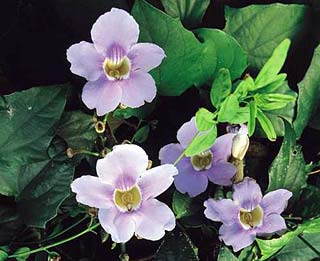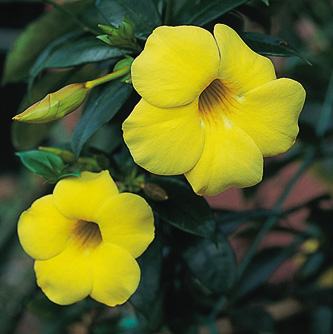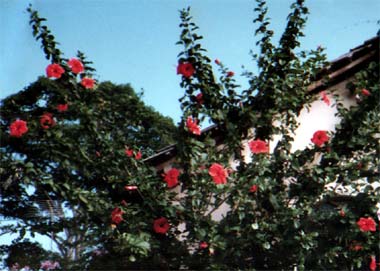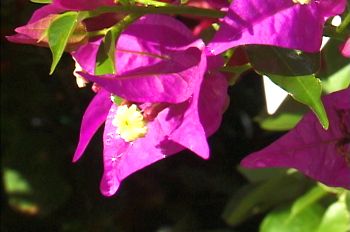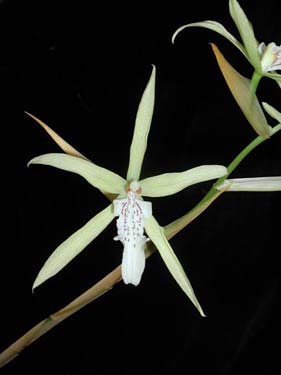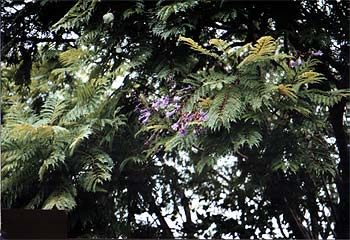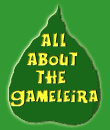|
|
|
|
|
|
| |
|
|
| |
|
What I
loved best about Trancoso was the way plants grew. No need of a green thumb,
just drop a seed and watch it become a tree. |
|
|
| |
|
|
|
|
| |
|
|
|
|
| |
|
cabana
covered by skyvine (Thumbergia) |
|
|
| |
|
|
|
|
| |
|
Our
property was a jungle of plants when we bought it, everything grew as it
liked, according to its needs of light and nutrition. There were a couple
of coffee trees, cacao trees, jack fruit trees and others with some crude
types of tangerines and lemons. On the trees other plants were growing.
Being myself more interested in flowers than fruit or vegetables, I didn't
plant many fruit trees, only a few favourites like mango or pomegranate. |
|
|
| |
|
Papaya
trees grew wherever somebody had previously eaten a papaya. Vegetables I
didn't plant at all, yet one season we suddenly had a big patch of cherry
tomatoes. This was typical for the way things just grew without anybody
having planted them. |
|
|
| |
|
|
|
|
| |
|
My
daughter took a few photos of trees and plants on her last visit to Trancoso.
Apart from the cashew tree, they all live on our property. |
|
|
| |
|
|
|
|
| |
|
Click
for enlargement.
| |
|
|
|
|
| |
|
|
|
|
| palmeira |
|
|
|
bananeira |
| |
|
|
|
|
| |
|
|
|
|
| |
|
|
|
|
| |
|
mamaõ
(papaya) |
|
cacau |
| |
|
|
|
|
|
|
|
| |
|
|
|
|
| |
|
A
very special tree is the gamelera, two big ones grew near the
pousada buildings. Also known as "strangler figs"
it is a very peculiar tree from the ficus family. It actually grows
around a host tree and suffocates it. If you're interested in more details,
you can read all about this fascinating trees in a separate window. |
|
|
| |
|
|
|
|
| |
|
Beneath
the trees, the ground was covered with rotting leaves, pieces of wood and
a mix of shrubs, bushes and weeds. Not few of those weeds I saw for sale
later at florists in Europe; in Trancoso they don't get noticed. Even orchids
didn't get appreciated by the locals, who cared more for edible plants. |
|
|
| |
|
The soil
was dark and very rich from all the organic waste of a couple of hundred
years of habitation around the village square. Further away from the village
center, in places where previously nobody had lived, the earth was very
different, quite sandy and barren. |
|
|
| |
|
|
|
|
| |
|
|
|
|
| |
|
Thumbergia
grandiflora (photo: web) |
|
|
| |
|
|
|
|
| |
|
To
build the Pousada we cleared most of the minor plants away, and
only left a few selected ones and all the healthy trees. I started to
plant hibiscus everywhere, some bougainvillea and oleander, groups of
lilies, amaryllis and other bulb plants. I also got me some climbers like
a beautiful light blue Thumbergia grandiflora (skyvine) and lovely
yellow allamanda, a native of Brazil. My favorite flowers are
roses though, hence the name of my restaurant and this web site: "Gulab
Mahal". |
|
|
| |
|
Ricardo,
a friend from the countryside of São Paulo, and a great lover of
plants and nature, once brought me 70 rose cuttings. Sadly,
only three of them survived in the subtropical climate of Bahia. |
|
|
| |
|
|
|
|
| |
|
|
|
|
| |
|
allamanda (photo: web) |
|
|
| |
|
|
|
|
| |
|
When we
came to Trancoso, I noticed only about three varieties of hibiscus. Soon
I learned that one only needs to cut a twig off a hibiscus bush, stick it
into a plastic bag filled with earth, and after a few weeks has a new plant.
So wherever I saw a new shade or type of hibiscus flowers I asked for a
branch and brought it home, ending up with dozens of bushes in fifteen different
varieties. An elderly lady in Porto Seguro told me about a long dead Colonel
she used to know who had grown 45 different hibiscus types. This may not
sound impressive for somebody living in a rich first world country, but
in our corner of Bahia there weren't much flowering plants for sale. About
once a year a truck with a limited choice of seedlings parked on the village
square and opened shop for a few hours. Hibiscus never were among his stock. |
|
|
| |
|
|
|
|
| |
|
|
|
|
| |
|
red hibiscus in front of the restaurant |
|
|
| |
|
|
|
|
| |
|
Brazilian
plant enthusiasts usually take the phases of the moon into consideration
when working with plants. Even in everyday life, the moon and its stages
plays a much more important part than it does where I grew up. This may
be connected to the fact that in warm climates, people spend a great part
of their time outdoors, in the evenings and nights as well, and see the
moon on a daily basis. If someone would ask me right now about the moon's
phase, I'd have to tell him that I haven't seen the moon for many days,
because it's winter in Switzerland and cold outside, and I wouldn't even
think of going outside at night if there's no urgent need. |
|
|
| |
|
|
|
|
| |
|
|
|
|
| |
|
bougainvillae (photo: web) |
|
|
| |
|
|
|
|
| |
|
In
front of the kitchen I planted two bougainvillaes, one of those grew to
be huge, its stem was like a tree trunk, and its splendid branches, generously
loaded with those magenta leaves (they're not actually flowers) grew like
an arch over the entrance to our next door neighbor's property. The neighbor
himself, instead of admiring his beautified dirt path, wanted to chop
the bougainvillae's branches off. An attitude typical for the male natives
of Trancoso, anything without practical value was useless to them. |
|
|
| |
|
|
|
|
| |
|
Whenever
possible, which wasn't too often because of the ongoing construction work
and the restaurant, I spent a day in the wilderness searching for orchids.
|
|
|
| |
|
|
|
|
| |
|
Looking
back to my time in Brazil, it’s evident to me that my main objective
weren't the plants. Orchids aren't my favorite flowers; roses are, as mentioned
before. |
|
|
| |
|
|
|
|
| |
|
It
was rather my desperate need to get away from my possessive, oppressive
psycho husband, who'd always holler for me wherever I was. Often I had
hardly sat down with a friend a few houses away when his voice boomed
over from our place, and I had to excuse myself and hurry back. His presence
hung over me like a dark cloud, and it was to get away from under this
cloud for at least a few hours that I started my forays into the forests. |
|
|
| |
|
|
|
|
| |
|
|
|
|
| |
|
Cattleya
amethystoglossa (photo: web), one of the many orchids found in Bahia |
|
|
| |
|
|
|
|
| |
|
On
the other hand, my love of searching and finding, never mind what, also
plays a part. This love must have its origin in some remnant genes passed
down from the times of my hunter and gatherer forebears. It's like a fever,
it starts with a low expectation of things to come, and builds up slowly
until the climactic moment of actually finding the coveted prize.
|
|
|
| |
|
It
does't need to be some material object, uncountable sleepless nights at
my comp are a valid proof that searching and finding some information on
the Internet does the same to me. When, after many hours of using every
trick that comes to my mind, of exploring dead ends and one-way streets,
I find an open door that leads me nearer to my objective, a feeling of triumphant
elation floods my mind and body, and I feel utterly content.
|
|
|
| |
|
|
|
|
| |
|
Back
to my forays though. The bus to Porto Seguro passed through miles of uninhabited
terrain, so I'd ask the driver to drop me off at some point I felt was
right. My equipment consisted only of a bag or a blanket to gather my
findings in. To me it was a strange world I was entering. Nothing like
the lush, emerald green tropical jungle I had expected to find in Brazil.
The green was rather yellowish or olive coloured, of a mottled, at times
even grayish dry appearance. Trees of various sizes, spotted with lichen
of every colour and description and a few parasitical plants riding piggyback
on their trunks, rose out of an underbrush of various shrubs and bushes
that wasn't difficult to navigate through. The quiet was broken only occasionally
by the sound of a bird, and apart from birds I never encountered another
animal, not even a snake or a sloth. Every once in a while the trees opened
unto a clearing, or gave way to bigger open spaces of tall grass with
cutting edges reaching up to my elbows, which was the main reason for
my legs and arms always being covered with cuts and scratches after a
day spent in the woods. |
|
|
| |
|
|
|
|
| |
|
|
|
|
| |
|
Miltonia
flavescens (photo: web), one of the less spectacular of Bahia's orchids |
|
|
| |
|
|
|
|
| |
|
Despite
been rather shortsighted myself, I had no trouble finding orchids even if
they were too far away for me to be actually seen clearly. It was like another
sense was involved, a sense that kind of picked up the orchid’s vibration
and directed me towards it. This may sound like bs to some people, but actually
the existence of what the British scientist Rupert Sheldrake calls “morphic
fields” (I never read his books, but from interviews and newspaper
articles I know what his theories are about) have always been a, albeit
hitherto nameless, fact of life to me. |
|
|
| |
|
|
|
|
| |
|
Be
that as it may, I never returned to Trancoso empty-handed. All the orchids
I brought back were fixed to the trees on our property, so they could
continue to grow in a protected environment, saved from the danger of
perishing through fire whenever a local family needed more land for their
sons to cultivate. From my friend Richardo I knew that it was still possible
to find some species of orchids that hadn't been catalogued yet. The ones
I came across rarely were in bloom, so there was no way of knowing beforehand
how their flowers would look like. What differed greatly were the dimensions:
Anything from a tiny yellow beauty where the entire plant was smaller
than my little finger, with yellow flowers the size of pinheads to plants
with leaves as long as my arm. |
|
|
| |
|
|
|
|
| |
|
My
best find was a huge plant sitting high up in the crown of a tree. As mentioned
before, due to my weak eyesight I could't really make out at a distance
if the plant actually was an orchid, nonetheless, I knew for sure that it
was one. Being useless at climbing trees myself, I had to memorize the location
and come back next day with someone to get the plant down for me. It was
the biggest orchid plant I had ever seen, and I sent a part of it to my
friend in Sao Paulo, while the other half continued its life in my garden.
I left Brazil soon after, but Fatima told me later about its huge white
flowers. |
|
|
| |
|
|
|
|
| |
|
One
of my favorite trees is the jacarandá with its lilac flowers.
A couple of those stood near the Kathmandu Post Office in Nepal, and to
see them in bloom always was a special treat for me. |
|
|
| |
|
I asked
Ricardo if he could find a jacarandá for me to plant out
in front of the restaurant. On his next visit to Bahia he brought me one,
it got planted and grew slowly but steadily. It had reached a height of
about 1 meter when I left Trancoso. In the years since, it has turned into
a big, splendid tree. Fatima took a photo for me: |
|
|
| |
|
|
|
|
| |
|
|
|
|
| |
|
my
jacarandá |
|
|
| |
|
|
|
|
| |
|
This brings to my mind an old saying that, in his lifetime,
a man should plant a tree, build a house and beget a son. If this applies
to the female sex as well, seems I've done my duty. |
|
|
| |
|
Thank God though I don't believe the above is all there is
to life. Much more important it is to learn and to spiritually grow, and
to always be ready for new lessons and new adventures. And that's nothing
you're ever done with. |
|
|
| |
|
|
|
|
| |
|
Apart
from the better known tropical fruit like papaya, mango, avocado, passion
fruit, or pineapple, there were many wild growing fruit trees in and around
Trancoso I'd never heard of before: Jenipapo, jambo, pitanga, mangaba,
carambola and the like. Jenipapo is a round brown fruit the
size of an orange. Cut into pieces and soaked in water, it makes for a delicious
drink. Jambo has a red skin and flesh as white as snow. Pitanga
are a kind of sour tasting orange-red berries, loved by the kids.
Mangaba are small round fruit of green colour. |
|
|
| |
|
Often
I encountered groups of small children, each carrying a vessel filled with
mangabas, bringing the fruit home for their mothers to make picolés.
A picolé is a home-made fruit-ice; small plastic bags
about an inch in diameter and 6 inches long are filled with fruit pulp,
water and sugar, and frozen. Selling picolés to the neighborhood
kids is a welcome opportunity for local housewives to earn a few cruzeiros. |
|
|
| |
|
The following
pics of fruit growing in and around Trancoso I found on the web. |
|
|
| |
|
|
|
|
|
|
| |
|
|
Click
for enlargement. |
|
|
|
| |
|
|
|
|
|
|
| |
|
|
|
|
|
|
| |
jambo |
|
jenipapo |
|
mangaba |
|
| |
|
|
|
|
|
|
| |
|
|
|
|
|
|
| |
|
|
|
|
|
|
| |
carambola |
|
cajú |
|
pitanga |
|
| |
|
|
|
|
|
|
| |
|
|
|
|
|
|
| |
|
|
|
|
|
|
| |
goiaba |
|
maracujá |
|
jaca |
|
| |
|
|
|
|
|
|
| |
|
Down near the beach there grew many cajú (cashew) trees.
Once a year we descended with the jeep to gather a some buckets full of
cashew fruits with their attached nuts. The nuts have to be roasted first
before they can be used, while the fruit itself is not entirely edible,
but its tasty juice can be sucked out. Superfluous fruit I sometimes let
turn into vinegar. Or the whole fruit can be simmered in sugar syrup until
it shrinks to hardly half its size and changes its colour to a mahogany
dark red. Such preserves are made with many types of fruit. |
|
|
| |
|
Another
time honoured custom is to make delicious liqueurs of some of the variety
of fruit locally available.Visiting with elderly ladies in Bahia is a good
opportunity to sample such treats. |
|
|
| |
|
|
|
|
| |
|
|
|
|
| |
|
|
|
|
| |
|
|
|
|
| |
|
|
 |
|


